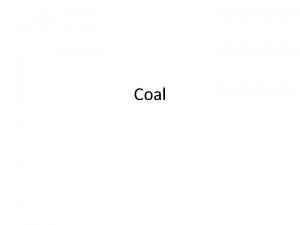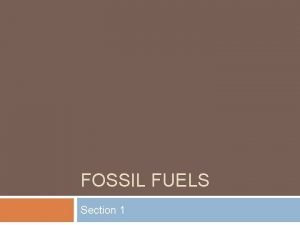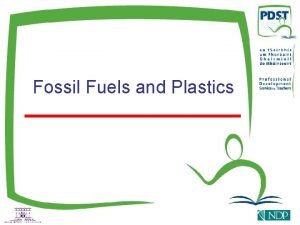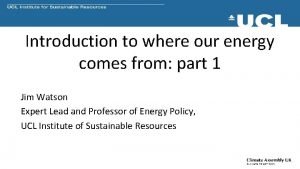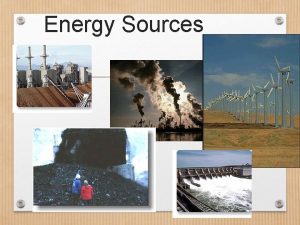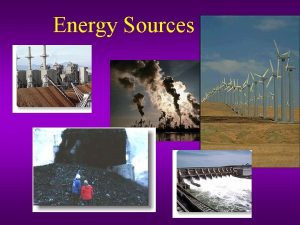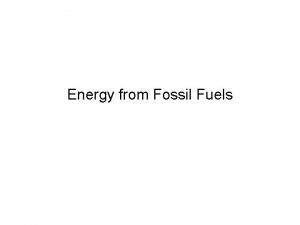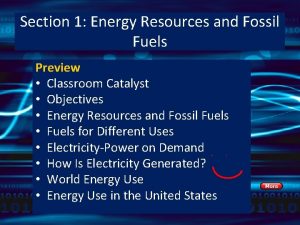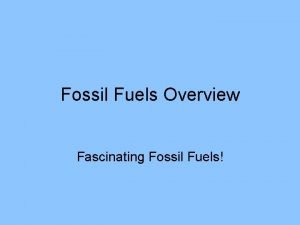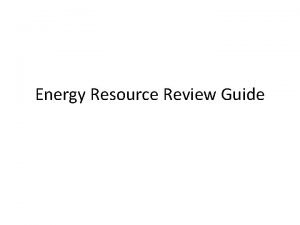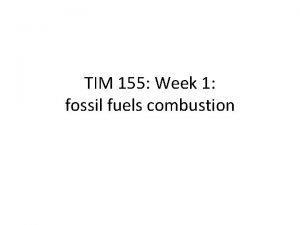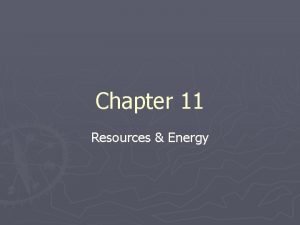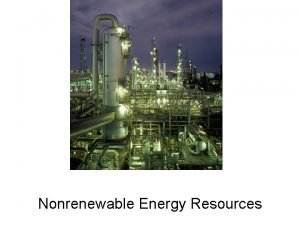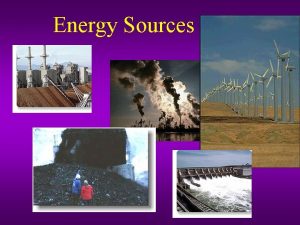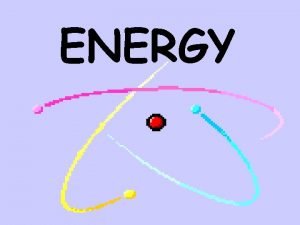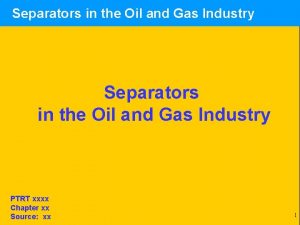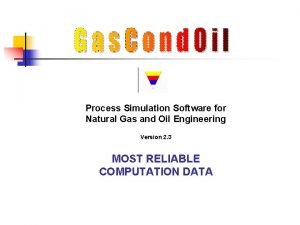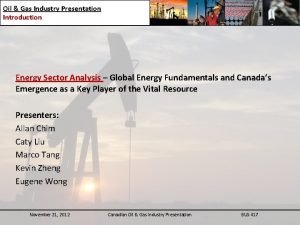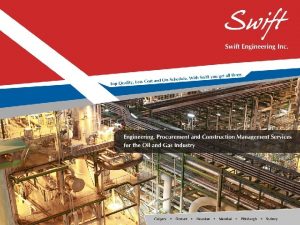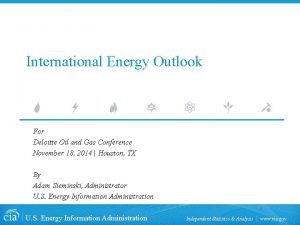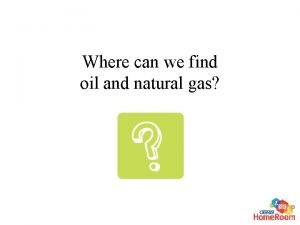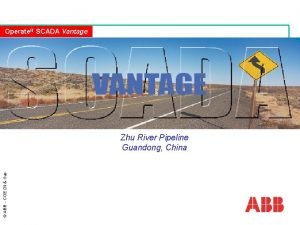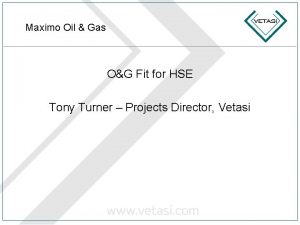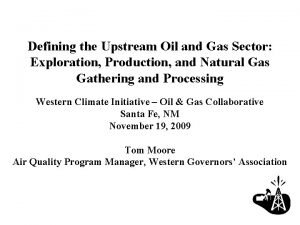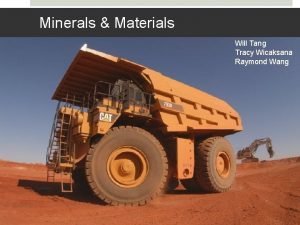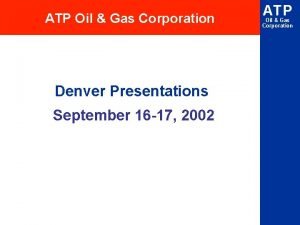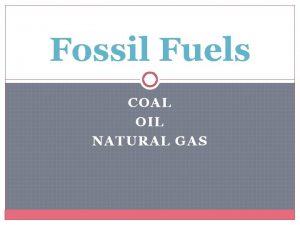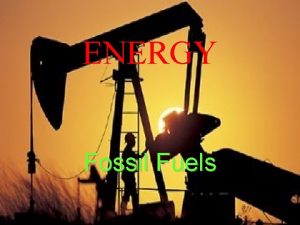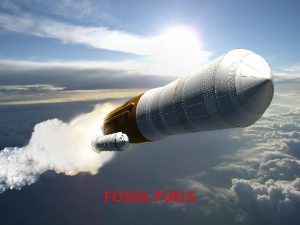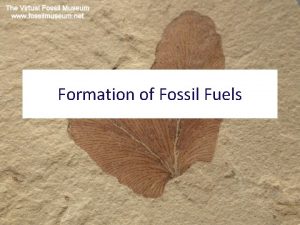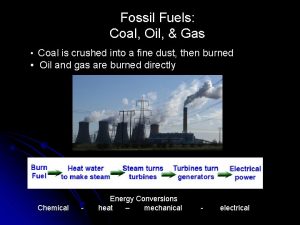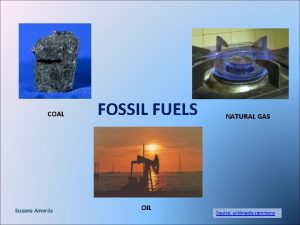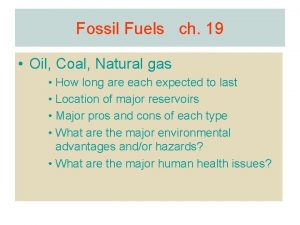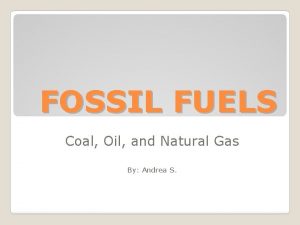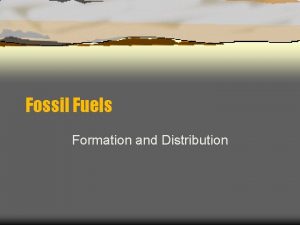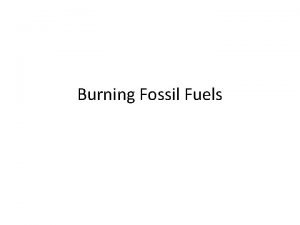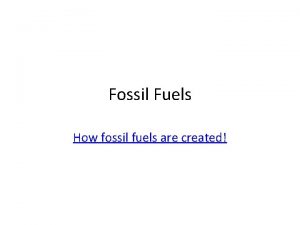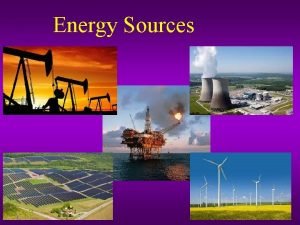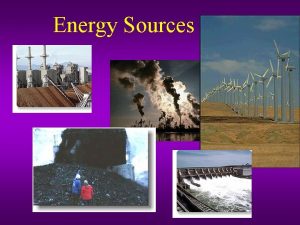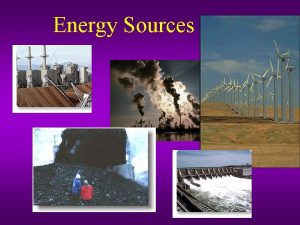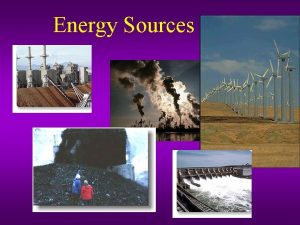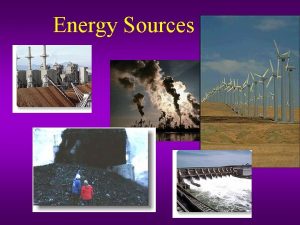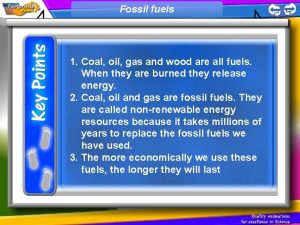Fossil Fuels COAL OIL NATURAL GAS Fossil Fuels

















































- Slides: 49

Fossil Fuels COAL OIL NATURAL GAS

Fossil Fuels provide most of the world’s energy in both DEVELOPED & DEVELOPING countries Developed countries roughly use about 1/3 of fossil fuels on industry, 1/3 on transportation, & 1/3 on everything else. Developing countries devote more energy to subsistence agriculture, food preparation, & home heating

How fossil fuels were formed �When organisms die, decomposers break down the dead biomass aerobically & it quickly enters food web �In places like swamps, river deltas, and the ocean floor, where there is little to no oxygen (anaerobic), decomposers cannot break down all the detritus (dead biomass) �The detritus is buried under layers of sediment & exposed to heat & pressure, transforming it into high -energy solid, liquid, and gaseous components

Coal

Coal �Coal is the most commonly used fuel for electricity generation in the U. S. �It is a solid fuel primarily made from the remains of trees, ferns & other plant material preserved 280360 millions of years ago The largest reserves of coal are found in The countries currently producing the greatest amounts of coal are 1. United States 2. Russia 3. China 4. India 5. Australia 1. 2. 3. 4. China United States India Australia

Types of coal �The five types of coal, ranked from lesser to greater age, exposure to pressure & energy content. The more exposure to pressure, the more energy: Peat (precursor to coal) Lignite Sub-bituminous Bituminous Anthracite (contains most energy) �Peat= a precursor to coal; made up of partly decomposed organic material, including mosses


Advantages of Coal �It’s energy-dense & plentiful! Thus it’s used to generate electricity & make products like steel �Relatively inexpensive & easy to exploit by surface mining Technological demands of surface mining are small & economic costs are low �As surface coal is used up & becomes harder to find, however, subsurface mining becomes necessary Subsurface mining has higher technological & economic costs, and the human health consequences increase as well �Once it’s extracted, it is easy to handle, can easily be transported & needs little refining before its burned �Thus it is a relatively easy fuel for any country to use

Disadvantages of Coal �Coal contains a number of impurities, that are released into the atmosphere when burned �Sulfur content ranges from 0. 4 -4% by weight Coal formed in marine sediment (vs freshwater) has the highest Causes industrial smog , acid deposition & acid mine drainage Lignite & anthracite have the lowest sulfur content Bituminous has the most �Contains trace amounts of mercury, lead & arsenic Neurotoxins

Coal Ash �There around 1, 450 coal mines in the U. S. �Most of the extracted coal is burned, but about 3 - 20% is left behind as ash

Coal Ash � Large deposits of ash are usually stored near the coal-burning power plants. One ash deposit in Knoxville, Tennessee, was mixed w/water & kept in a holding pond. In Dec. 2008, the retaining wall that contained it gave way & spilled 1. 1 billion gallons of ash. � Three homes were destroyed by the flow of muddy ash � This event is the largest of its kind & the clean-up is still ongoing

Carbon dioxide �Coal is 60 -80% carbon �When it is burned (combusted) most of its carbon is converted into CO 2 �Coal produces far more CO 2 per unit energy released than natural gas or oil.

Petroleum Nations with Largest Reserves: 1. Saudi Arabia 2. Iran 3. Iraq 4. Kuwait 5. United Arab Emirates 6. Venezuela 7. Russia

Petroleum �Petroleum is a fluid mixture of hydrocarbons, water, and sulfur that occurs in underground deposits �The fluid nature of petroleum products such as oil and gasoline makes them ideal for mobile combustion applications, such as vehicles

Petroleum �It is formed from the remains of ocean-dwelling phytoplankton (microscopic algae) that died 50 -150 million years ago. �Deposits of phytoplankton are found in locations where porous sedimentary rocks, such as sandstone, are capped by nonporous rocks. Petroleum forms over millions of years & fills the pore spaces in the rock Geologic events may deform the rock layers so that they form a dome The petroleum is less dense than the rock, so it will migrate upward toward the highest point in the porous rock

Petroleum extraction � Geologists search for oil by drilling rock cores & conducting ground, air & seismic surveys � In some locations, petroleum flows under pressure the way water flows from an artesian well � But usually producers must drill wells into a deposit & extract the petroleum with pumps.

Petroleum Extraction �Primary extraction= initial drilling & pumping of available oil �Secondary extraction= solvents are used or underground rocks are flushed with water or steam to remove additional oil

Petroleum extraction �After extraction the petroleum must be transported by pipeline, if the well is on land or by supertanker (ship) if it is underwater, to a petroleum refinery Remember, oil (& natural gas) can be extracted on land or on offshore drilling platforms when it is being extracted from the seafloor

Keystone Pipeline � The Keystone Pipeline System is an oil pipeline system in Canada and the United States, commissioned since 2010. � It runs from the Western Canadian Sedimentary Basin in Alberta to refineries in Illinois and Texas, and also to oil tank farms and oil pipeline distribution center in Oklahoma

Keystone Pipeline � Three phases of the pipeline are in operation & the 4 th phase is awaiting govt. approval � Phase IV would essentially duplicate the Phase I pipeline between Alberta, Canada & Nebraska, with a shorter route and a larger-diameter pipe. � It would run through Baker, Montana, where Americanproduced light crude oil from the Williston Basin (Bakken formation) of Montana and North Dakota would be added to the Keystone's current output

Petroleum contains natural gas �Workers usually burn the natural gas under controlled conditions to prevent an explosion Some of the gas can also be extracted to use as a fuel Offshore drilling platform

Petroleum �Petroleum removed from ground is often referred to as oil/crude oil �Crude oil is taken to an oil refinery, where it can be refined into products like tar & asphalt, gasoline & diesel, and kerosene These compounds are distinguished by the temperature in which they boil & can be separated by heating the petroleum �The refining process is complex and dangerous & requires a major financial investment

Oil refineries �There around 150 oil refineries in the U. S. �Oil production & sales are measured in barrels of oil �One barrel= 160 liters (42 gallons)

U. S. & petroleum use � The U. S. uses more petroleum than any other fuel � We use 3. 1 billion liters (816 million gallons) per day Gasoline accounts for roughly ½ of that amount � The primary use of petroleum products is for transportation, but it is also the raw material for petrochemicals, such as plastics, lubricants, raw material for pharmaceuticals & cleaning solvents Top-petroleumproducing countries 1. 2. 3. 4. 5. 6. 7. Saudi Arabia Russia United States Iran China Canada Mexico These 7 counties account for roughly ½ of worldwide oil production

Ways petroleum is used besides transportation

Advantages & Disadvantages of petroleum �Easy to transport & use �Energy-dense & cleaner-burning than coal Produces CO 2 when it is combusted in automobile & jet engines, however, it produces only 85% as much CO 2 as coal does �Just like coal, it contains trace amounts of sulfur, mercury, lead & arsenic �When drilling for oil, there is the potential for leaks But remember, aside from large oil spills, 85% of oil entering marine waterways actually comes from runoff from land & rivers, airplanes & small boats

Oil Reserves �Oil is a precious resource and scientists are trying to determine how much we have left �To increase oil production, we are also extracting oil from sand shale, less conventional deposits of petroleum �However, they are expensive to extract, & process, making their net energy values low Oil Shale

Oil Sands (Tar Sands) �These are deposits of moist sand clay containing 1 - 20% bitumen, a thick & heavy form of petroleum that is rich in carbon & poor in hydrogen. �They are crude oil deposits that have been degraded & chemically altered by water erosion & bacterial decomposition �They are too thick to be extracted by oil drilling, so they are generally removed by strip mining, specifically in situ extraction, where steam or chemical solvents are injected to liquefy the bitumen so it can be extracted through wells �After extraction, the bitumen is refineries where it is refined into valuable synthetic crude oil, by the addition of hydrogen and removal of carbon

Oil Sands (Tar Sands) �Largest deposits are in eastern Venezuela and northeastern Alberta, Canada

Oil Shale �Oil shale= sedimentary rock filled with kerogen (organic matter) that can be processed to produce liquid petroleum �It is formed same way as crude oil, but occurs when kerogen is not buried deep enough or subjected to enough heat & pressure to form oil �It is extracted through strip mining and subsurface mining �Once mined, it can be burned directly like coal or baked in the presence of hydrogen & absence of air to extract liquid petroleum �The oil industry is developing in situ extraction in which rock is heated underground to liquefy and release oil into wells

Oil Shale �About 40% of global oil shale reserves are in the U. S. , specifically Colorado, Wyoming & Utah

Alternative to petroleum: Liquefied coal �As petroleum resources start to diminish, coal might be the answer The U. S. and China have immense supplies of coal. �The technology to convert solid coal into liquid fuel– a process known as CTL, “coal-to-liquid”– has been available for decades. �CTL process is expensive & has many of the same drawbacks as exploiting oil sands but it has the potential to eliminate U. S. dependence on foreign oil But, EPA estimates the total greenhouse gas emissions from liquefied coal are more than twice those from conventionally produced oil

Natural Gas

Natural Gas 2 types of deposits: �Biogenic gas= created at shallow depths by anaerobic decomposition of organic matter by bacteria Pure methane, CH 4 Produced in places like: Landfills, wetlands �Thermogenic gas= results from compression& heat deep underground Pressure is exerted by overlying sediment and temperature increases, causing carbon bonds to break down, turning it into kerogen (a source for both natural gas, crude oil & coal) Contains methane, as well as small amounts of other gas as well

Natural Gas �Most natural gas extraction is thermogenic �This type of natural gas is 80 -95% methane (CH 4) & 5 -20% ethane, propane & butane Because natural gas is lighter than oil & coal, it lies above the other deposits. Thus natural gas is generally extracted in association with petroleum & coal Only recently has exploration specifically for natural gas been conducted (fracking)

Natural Gas Being Wasted �Often natural gas goes to waste as it escapes from coal mines and oil wells because it can easily leak into atmosphere during mining process �Natural gas can also be expensive to transport in remote oil-drilling areas, so it is just burned off

Natural Gas �The two largest uses of natural gas in the U. S. are electricity generation & industrial processes. It is an efficient fuel for cooking, heating & operating clothes dryers & water heaters �It is also used to make nitrogen fertilizer

Natural Gas Deposits �Deposits of natural gas are greatest in Russia & the Middle East �Russia & the United States lead the world in natural gas production and consumption

Natural Gas used as a Fuel �Compressed natural gas can be used as a fuel for vehicles But because it must be transported by pipeline, it is not accessible in all parts of the U. S. & therefore is unlikely to become an important fuel for cars �Liquefied petroleum gas (LPG)– which is similar to natural gas, but in liquid form– is a slightly less energy-dense substitute LPG can be transported via train or truck & stored at a point of use in tanks This fuel is available practically everywhere in the U. S. & can be used in place of natural gas & for portable BBQ grills & heaters

Natural Gas & LPG supplies 24% of the energy used in the U. S. �Natural gas field in Wyoming

Advantages of Natural Gas �½ of homes in U. S. use natural gas for heating This is due to the extensive natural gas pipeline system in many parts of the U. S. � Remember: an environmental consequence of pipelines can be disruptive to organisms �Natural gas is often described as the “clean” fossil fuel Compared to oil & coal, natural gas contains fewer impurities & therefore emits almost no sulfur dioxide or particulates during combustion Natural gas emits half as much CO 2 as coal and only 2/3 as much as oil

Disadvantages of Natural Gas �Unburned natural gas (methane, CH 4) that escapes into the atmosphere is a greenhouse gas �CH 4 is 25 times more efficient at absorbing infrared energy than CO 2 The leaking of natural gas after extraction is a suspected contributor to the steep rise in atmospheric methane concentrations that were observed in the 1990 s

Extraction of Natural Gas �Exploration of natural gas takes place on land under water �Exploring natural gas on land involves using “thumper trucks” which generate seismic vibrations in order to identify natural gas deposits underground This can disturb soil and alter groundwater flow, causing certain areas to flood & wells to go dry

Extraction of Natural Gas �To access the deposits, they need to drill for an opening �This will increase pressure and the low molecular weight of natural gas will drive the gas upward naturally. �If that doesn’t work, the gas will need to be pumped to Earth’s surface, commonly with the help of a horsehead pump Horsehead Pump

Extraction of Natural Gas �Like oil and coal, many of the most accessible natural gas reserves have already been exhausted �U. S. wells today produce about ¼ as much as they did in the 1970 s

Extraction of Natural Gas: Fracking �The process of drilling & opening up rock containing natural gas in order to release the natural gas is called hydraulic fracturing, or “fracking” �Fracking involves drilling with water, sand & chemicals The chemicals used in this process are unknown, as the companies don’t have to be release this information to the public The large quantities of water used becomes contaminated with these chemicals (including the methane itself) & must be disposed of afterward � There is often groundwater contamination resulting from the drilling of natural gas wells (potential drinking water contamination)

Fossil Fuels are a Finite Resource • FOSSIL FUELS TAKE MILLIONS OF YEARS TO FORM • THERE IS NO WAY TO LIMIT OUR CONSUMPTION TO THE RATE AT WHICH FOSSIL FUELS ARE FORMED

Fossil Fuels are a Finite Resource • IF WE CONTINUE OUR GLOBAL USE PATTERNS: • OIL RESERVES WILL RUN OUT IN LESS THAN 40 YRS • NATURAL GAS WILL LAST ABOUT 60 YEARS • COAL SUPPLIES WILL LAST FOR AT LEAST 200 YRS, MAYBE LONGER

The answer… USING RENEWABLE RESOURCES OF ENERGY • USING URANIUM RESOURCES IN NUCLEAR ENERGY •
 Abundant fossil fuel
Abundant fossil fuel Coal is a solid fossil fuel formed from plant remains
Coal is a solid fossil fuel formed from plant remains Coal oil
Coal oil Coal, oil
Coal, oil Positives and negatives of fossil fuels
Positives and negatives of fossil fuels Advantages of fossil fuels
Advantages of fossil fuels Advantages of using oil
Advantages of using oil What are the environmental impacts of fossil fuels
What are the environmental impacts of fossil fuels Similarities between biofuels and fossil fuels
Similarities between biofuels and fossil fuels Deposit
Deposit Advantages and disadvantages of fossil fuels
Advantages and disadvantages of fossil fuels Fossil fuels include
Fossil fuels include Fossil fuels summary
Fossil fuels summary Fossil fuels include
Fossil fuels include Fossil fuels formula
Fossil fuels formula Fossil fuels
Fossil fuels Natural gas advantages
Natural gas advantages Benefits of using fossil fuels
Benefits of using fossil fuels The oldest source of energy
The oldest source of energy Emulsion for external use
Emulsion for external use Types of separators in oil and gas industry
Types of separators in oil and gas industry Scott can industries
Scott can industries Process simulation software in oil and gas market
Process simulation software in oil and gas market Introduction to oil and gas industry ppt
Introduction to oil and gas industry ppt Maximo work scheduling
Maximo work scheduling Gomaximo
Gomaximo Madagascar oil and gas
Madagascar oil and gas Oil & gas engineering services
Oil & gas engineering services Deloitte oil and gas outlook
Deloitte oil and gas outlook Oil gas partition coefficient inhaled anesthetics
Oil gas partition coefficient inhaled anesthetics Hitachi vantara oil and gas
Hitachi vantara oil and gas Risk management case study oil and gas industry
Risk management case study oil and gas industry Drops oil and gas
Drops oil and gas Uses of oil and gas
Uses of oil and gas Atb oil and gas
Atb oil and gas Stc devices
Stc devices Abb scadavantage
Abb scadavantage Osu oil and gas accounting conference
Osu oil and gas accounting conference Maximo scheduler run optimization
Maximo scheduler run optimization Maximo oil and gas
Maximo oil and gas What is an energy role
What is an energy role Oil and gas
Oil and gas Oil and gas revenue accounting basics
Oil and gas revenue accounting basics Costless collar oil
Costless collar oil Oil and gas company
Oil and gas company Maximo oil and gas
Maximo oil and gas Due diligence checklist for oil and gas properties
Due diligence checklist for oil and gas properties Diversifying oil and gas portfolio
Diversifying oil and gas portfolio Full cost method of accounting oil and gas
Full cost method of accounting oil and gas Gas 101
Gas 101
